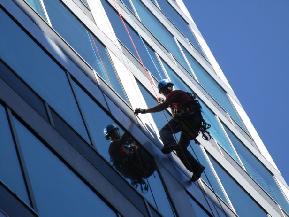 Bob Geiger
Bob Geiger
June marked the beginning of the yearly hurricane season, with prime storm activity in the Atlantic Ocean historically occurring between the months of August and October. And while certain cities remain consistently vulnerable to significant damage, robust coastal CRE development from Texas up to Maine has made preparedness and structural assessment a more urgent issue. A recurring trend of highly destructive weather events will necessitate long term considerations from owners, investors and lenders about the infrastructure risk natural disasters pose to their assets, ways to mitigate secondary post-storm damage, and how to seize opportunities for implementing safer, more resilient, commercially cost-effective building design in the future. Resiliency is a trendy term in CRE asset management, particularly pertaining to severe weather events such as hurricanes and tornadoes. True resiliency, however, involves broadening your lens to include all safety and property risk assessments.
Below are some key considerations:
Predicting Wind and Storm Damage:
Fifteen of the 30 costliest hurricanes in history all occurred between 2004 to 2013, with each causing over $1 billion in damage. The resulting, increasing trend is that real estate lenders, investors and owners are turning to predictive assessments for probable wind damage to inform their risk management decisions. Indeed, there is currently no uniform industry standard for assessing windstorm losses and damage in vulnerable hurricane zones comparable to a seismic probable maximum loss assessment. ASTM International is proposing developing a new Probable Maximum Loss-like standard, a “Wind PML,” to assess infrastructure risk in the event of high winds associated with hurricanes. Jane Powell, PE, of Partner Engineering and Science, Inc. has been tapped to chair a committee tasked with establishing Wind PML standard guidelines, as well as qualifications for professionals performing the assessments. If you are at the forefront of real estate transactions in hurricane zones or are concerned about current equity, please don’t hesitate to reach out to my colleague Jane with thoughts and input towards discussion of these standards.
Anticipating and Responding to Flooding
Heavy rains, storm surges, and wind from hurricanes (even moderate Category 2 storms) often create extensive flooding damage to buildings and external areas. This, in turn, creates additional human health hazards, such as mold, fungus, sewage, exposed asbestos, possibly lead (depending on the age of the structure), as well as broader safety hazards such as a highly contaminated water supply and downed or exposed electrical lines. Be storm ready by ensuring that your property institutes proper ventilation schematics, uses durable, storm-resistant building materials (upgrade if necessary), and that HVAC, plumbing, mechanical and other building systems are up to date. Engagement with a proactive, multidisciplinary engineering due diligence consultant can help you assess and address risk, preparedness and a post-disaster remediation plan to safely address mold, asbestos and other hazards.
Seismic Risk Assessment
It’s always beneficial to think about earthquake building resilience, particularly during a time of the year when many CRE professionals have safety and risk management on their minds. While most people associate earthquake risk exclusively with California, due largely to population shifts and newfound discoveries about the prevalence of earthquake tremors, approximately half the United States population living in 48 contiguous states is at risk for an earthquake. Incorporating a thorough, comprehensive PML assessment has the added benefit of asking many of the same structural safety questions pertinent to any natural disaster losses. There is notable political momentum towards compulsory regulations for rehabilitation of seismically vulnerable buildings. In California, for example, large cities like Los Angeles and San Francisco have either proposed or passed preemptive ordinances to identify and retrofit thousands of buildings. Seismic retrofits help to strengthen properties to minimize losses, and ultimately, save lives in the event of an earthquake.
Use Sustainability and Durability for Long-Term Resiliency
In some cases, buildings that have not been structurally fortified will suffer insurmountable losses from hurricane damage. Lenders and builders should consider these opportunities to use principles of sustainability, efficiency and constructability to plan for the future. In 2007, the city of Greenburg, KS was leveled by a tornado that destroyed 90% of infrastructure and homes. Their wholesale rebuild involved use of modern construction methods, including precast concrete, along with green sustainability infrastructure. Their efforts resulted in a number of gold and platinum LEED-certified buildings and a more resilient, energy efficient and stable community infrastructure of the future.
Systems Security
As machine learning, artificial intelligence and inter-connected systems technology become integrated in virtually every aspect of modern life, future “smart” buildings will be entirely automated for function and sustainability. Energy usage will be monitored and adjusted (windows, lights, water consumption) as buildings are able to adapt and learn in real time, while centralized command centers will streamline and control all building systems such as electricity, heating and air conditioning, elevators, and internal communications. Consider prioritizing best basic practices for maintaining function and accessibility in brick and mortar infrastructure and building systems as well as hiring a due diligence consultant for comprehensive engineering, sustainability and infrastructure risk assessments.
Eventually, resiliency ranking may become a better indicator of global portfolio and risk decisions than property yields and interest rates. Long term forecasts by lenders, investors and owners are taking into account coastal impacts associated with rising sea levels, population demographic shifts, and the value of large urban conglomerates relative to how prime real estate bounces back from severe weather events. Prioritizing investments in future upgrades to the resiliency of buildings is economically critical for lenders, owners and investors. Improved resiliency can: prevent costly damage in case of a storm; ensure the safety of tenants (thereby avoiding liability); ensure compliance with regulations; and improve returns on investment (future tenants/buyers will want to pay a premium for more resilient buildings).

















 Copyright © 2024 ALM Global, LLC. All Rights Reserved.
Copyright © 2024 ALM Global, LLC. All Rights Reserved.